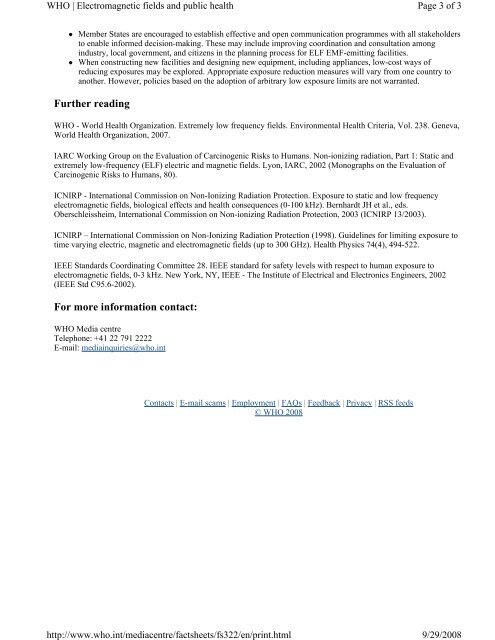Dear Customer: Your inquiry about electric and magnetic fields is ...
Dear Customer: Your inquiry about electric and magnetic fields is ... Dear Customer: Your inquiry about electric and magnetic fields is ...
WHO | Electromagnetic fields and public health Member States are encouraged to establish effective and open communication programmes with all stakeholders to enable informed decision-making. These may include improving coordination and consultation among industry, local government, and citizens in the planning process for ELF EMF-emitting facilities. When constructing new facilities and designing new equipment, including appliances, low-cost ways of reducing exposures may be explored. Appropriate exposure reduction measures will vary from one country to another. However, policies based on the adoption of arbitrary low exposure limits are not warranted. Further reading WHO - World Health Organization. Extremely low frequency fields. Environmental Health Criteria, Vol. 238. Geneva, World Health Organization, 2007. IARC Working Group on the Evaluation of Carcinogenic Risks to Humans. Non-ionizing radiation, Part 1: Static and extremely low-frequency (ELF) electric and magnetic fields. Lyon, IARC, 2002 (Monographs on the Evaluation of Carcinogenic Risks to Humans, 80). ICNIRP - International Commission on Non-Ionizing Radiation Protection. Exposure to static and low frequency electromagnetic fields, biological effects and health consequences (0-100 kHz). Bernhardt JH et al., eds. Oberschleissheim, International Commission on Non-ionizing Radiation Protection, 2003 (ICNIRP 13/2003). ICNIRP – International Commission on Non-Ionizing Radiation Protection (1998). Guidelines for limiting exposure to time varying electric, magnetic and electromagnetic fields (up to 300 GHz). Health Physics 74(4), 494-522. IEEE Standards Coordinating Committee 28. IEEE standard for safety levels with respect to human exposure to electromagnetic fields, 0-3 kHz. New York, NY, IEEE - The Institute of Electrical and Electronics Engineers, 2002 (IEEE Std C95.6-2002). For more information contact: WHO Media centre Telephone: +41 22 791 2222 E-mail: mediainquiries@who.int Contacts | E-mail scams | Employment | FAQs | Feedback | Privacy | RSS feeds © WHO 2008 http://www.who.int/mediacentre/factsheets/fs322/en/print.html Page 3 of 3 9/29/2008
- Page 1 and 2: Dear Customer: Your inquiry about e
- Page 3 and 4: Ann Almonte 1-800-200-4723 NORTHERN
- Page 7 and 8: EMF Research & Education Name: Plea
- Page 9 and 10: From 210 Fwy. going East, exit at I
- Page 11: WHO | Electromagnetic fields and pu
WHO | Electro<strong>magnetic</strong> <strong>fields</strong> <strong>and</strong> public health<br />
Member States are encouraged to establ<strong>is</strong>h effective <strong>and</strong> open communication programmes with all stakeholders<br />
to enable informed dec<strong>is</strong>ion-making. These may include improving coordination <strong>and</strong> consultation among<br />
industry, local government, <strong>and</strong> citizens in the planning process for ELF EMF-emitting facilities.<br />
When constructing new facilities <strong>and</strong> designing new equipment, including appliances, low-cost ways of<br />
reducing exposures may be explored. Appropriate exposure reduction measures will vary from one country to<br />
another. However, policies based on the adoption of arbitrary low exposure limits are not warranted.<br />
Further reading<br />
WHO - World Health Organization. Extremely low frequency <strong>fields</strong>. Environmental Health Criteria, Vol. 238. Geneva,<br />
World Health Organization, 2007.<br />
IARC Working Group on the Evaluation of Carcinogenic R<strong>is</strong>ks to Humans. Non-ionizing radiation, Part 1: Static <strong>and</strong><br />
extremely low-frequency (ELF) <strong>electric</strong> <strong>and</strong> <strong>magnetic</strong> <strong>fields</strong>. Lyon, IARC, 2002 (Monographs on the Evaluation of<br />
Carcinogenic R<strong>is</strong>ks to Humans, 80).<br />
ICNIRP - International Comm<strong>is</strong>sion on Non-Ionizing Radiation Protection. Exposure to static <strong>and</strong> low frequency<br />
electro<strong>magnetic</strong> <strong>fields</strong>, biological effects <strong>and</strong> health consequences (0-100 kHz). Bernhardt JH et al., eds.<br />
Oberschle<strong>is</strong>sheim, International Comm<strong>is</strong>sion on Non-ionizing Radiation Protection, 2003 (ICNIRP 13/2003).<br />
ICNIRP – International Comm<strong>is</strong>sion on Non-Ionizing Radiation Protection (1998). Guidelines for limiting exposure to<br />
time varying <strong>electric</strong>, <strong>magnetic</strong> <strong>and</strong> electro<strong>magnetic</strong> <strong>fields</strong> (up to 300 GHz). Health Physics 74(4), 494-522.<br />
IEEE St<strong>and</strong>ards Coordinating Committee 28. IEEE st<strong>and</strong>ard for safety levels with respect to human exposure to<br />
electro<strong>magnetic</strong> <strong>fields</strong>, 0-3 kHz. New York, NY, IEEE - The Institute of Electrical <strong>and</strong> Electronics Engineers, 2002<br />
(IEEE Std C95.6-2002).<br />
For more information contact:<br />
WHO Media centre<br />
Telephone: +41 22 791 2222<br />
E-mail: mediainquiries@who.int<br />
Contacts | E-mail scams | Employment | FAQs | Feedback | Privacy | RSS feeds<br />
© WHO 2008<br />
http://www.who.int/mediacentre/factsheets/fs322/en/print.html<br />
Page 3 of 3<br />
9/29/2008



